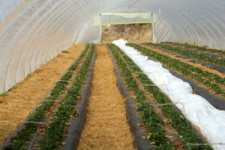How To High Tunnel


There is increasing interest among some growers in the use of high tunnels for vegetable production. Florida Grower and its sister publications hosted a webinar this past fall on the topic. More than 350 people signed up to view the webinar, which covered the areas of irrigation, soil management, and use of biocontrols in high tunnels.
Matt Kleinhenz, vegetable specialist with The Ohio State University, discussed the importance of cultural management in high tunnel production. “An ounce of prevention is worth a pound of cure,” he says. “This is true in high tunnel production. A proper cultural management plan is a cornerstone in integrated crop management and integrated pest management and helps reduce the need for pesticides, fertilizer, and possibly water.”
One of the most important items in high tunnel production is having a clear picture of the soil type or medium being grown in and its ability hold water and fertilizer. Understanding a particular crop’s needs for both changes with the season and growth stage also is critical to successful production. “The goal is to apply just the right amount of water and nutrients,” says Kleinhenz. “Too little or too much of either has bad consequences.”
To manage water and nutrients correctly, Kleinhenz recommends a whole farm planning approach, which takes into account nutrient uptake, binding, leaching, and runoff. In simple terms, you keep track of the fertilizer that enters the high tunnel and leaves the high tunnel in its different forms. This requires good recordkeeping, but it pays off in ensuring proper fertilization.
Soil sampling is another very important process in whole farm planning. “It represents a small fraction of total production costs with a potentially high return on investment,” says Kleinhenz. “We also recommend petiole testing, so growers can fine tune fertility needs as the crop grows.”
Hand In Hand
Clay soils tend to create wider, flatter wetting patterns, while sandy soils create deeper, narrow wetting patterns. Soil type should be taken into account to adjust emitter spacing, irrigation timing, and intensity. This ensures water and nutrients are distributed in the root zone and not wasted outside or below it. Frequent and short bursts keep water and nutrients high in the soil profile, while less frequent and longer irrigation drives nutrients and water deeper.
Amend And Rotate
Additional Options
Trials show grafted tomatoes on deficit water can produce similar yields to ungrafted tomatoes on standard irrigation programs.
Biocontrol’s Role
“We have studied the use of biocontrols and predatory insects in greenhouses for years and have adapted this knowledge to high tunnels,” says Orzolek. “In greenhouses, we’ve found these predators to be very effective in controlling insects like whiteflies, aphids, and spider mites.
“If you are interested in trying biocontrol methods in your high tunnel, start small and learn the system first. Start with 600 to 2,000 square feet where you find a problem and initiate your biocontrol program and manage the problem over time.”
Clean Start
Orzolek also recommends seeking out disease- and insect-free transplants. He advises growers not grow ornamental and vegetable transplants together, because this can spread disease and pests among the crops. “If you start out with problems in your transplants, it will be a long-term problem,” he says.
Keeping weeds controlled around the high tunnel is another important step in keeping pest numbers low. “Because weeds can serve as a reservoir for some insect pests, if there are enough outside the high tunnel, it can upset the balance of predator to prey inside the tunnel. We really like a situation where it is fairly clean outside the tunnel because of the pests and the fact weeds also can harbor viruses.”









